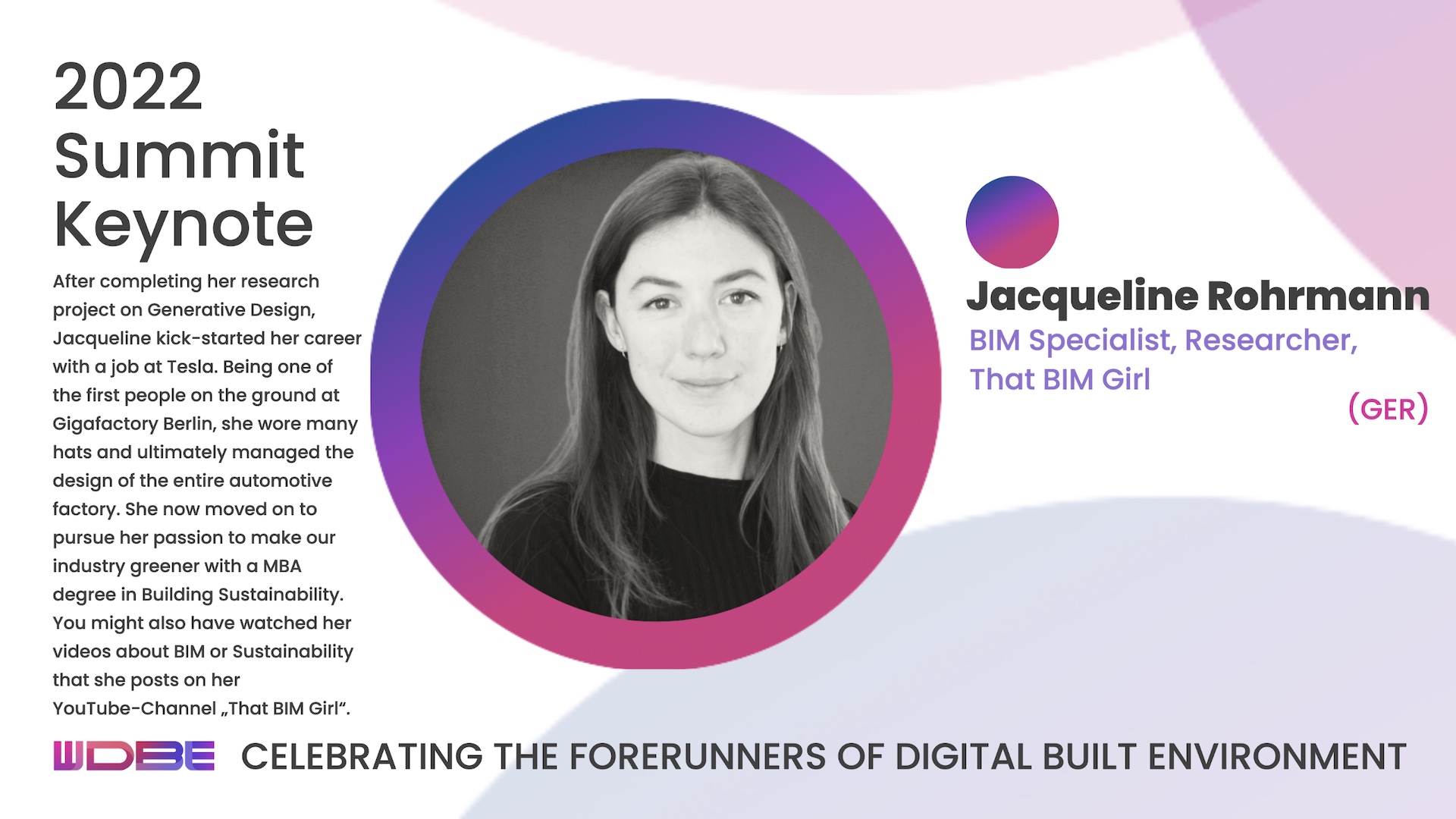Aarni Heiskanen had the pleasure of meeting with Jacqueline Rohrmann, a keynote speaker at the WDBE 2022 conference. She talked about the digitalization of the construction sector, her experiences as a design manager at Tesla, and the industry’s future.
If you’re a designer learning to use Revit, a BIM tool, you might have watched some of Jacqueline’s instructional videos on her YouTube channel. She had a very practical reason for taking up video blogging and launching her channel.
“I was just so frustrated with the way that people were using Revit and that they weren’t using it properly, and I was just thinking, oh, I should educate people. People should know how to work better with these digital tools,” Jacqueline says.
Jacqueline’s channel, That BIM Girl, became a great success. Her positive attitude and personality outshone the dull and monotonous training that is typical for software instructions and helped her attract many viewers. She now has over 20 thousand subscribers, and her videos get tens of thousands of views.
Lately, Jacqueline has shifted her focus from BIM training to also sharing her thoughts about sustainability. Following her passion, she’s now doing an MBA program specializing in building sustainability. This is on top of the degrees she already holds in architecture and civil engineering.
Joining Tesla’s Gigafactory project in Berlin
After working as a BIM specialist for a couple of years, Jacqueline joined a project that many European countries had yearned to host, the Tesla Gigafactory.
Tesla’s CEO, Elon Musk, announced in November 2019 that the first European Gigafactory would come to Grünheide, 35 kilometers southeast of central Berlin. While the original team came from the USA, Tesla also wanted to include locals to run the project, and in March 2020, Jaqueline became one of the first German hires as the BIM manager of Gigafactory.
“I got to work with the people from the US and got the Tesla spirit and the DNA, which was really exciting. And I think the spirit and the mentality were very different from your average German project,” Jacqueline remarks.
Soon after Jaqueline had joined Tesla, the pandemic threw a wrench into the works. The US personnel flew home because they feared the borders might be closed. That left a small local team behind to manage the project. Fortunately, they could pull through with digitalized processes and cloud-based systems. As a design manager, Jaqueline could collaborate with a global team that worked somewhere on the planet every hour of the day. She says that such an endeavor would not have been possible without the use of apps in such a tight timeframe.
The stellar project team triumphed, and the four-billion-euro Giga Berlin opened its doors on March 22, 2022. It now has over 8000 employees, and it is expected it will eventually produce half a million electric cars annually.
How to do the right thing
Jacqueline remembers having actively thought about her life’s vision in her 20s. Her vision could be crystallized into the mantra: “I want to do the right thing.” At first, this meant digitalizing the construction sector and advancing BIM use. Currently, the right thing to do is reduce and hopefully reverse the industry’s negative impact on the planet.
Construction is a necessary function of society, but it’s also a massive energy consumer and carbon dioxide emitter. Cement production alone contributes to eight percent of global emissions, and construction accounts for 40 percent of waste, Jaqueline reminds.
Right now, Jacqueline is looking into renewable energy and efficient battery technologies. She’s also interested in the information side of sustainable construction; how we can visually analyze and visually present environmental building information in an easy-to-grasp format in digital dashboards, for example.
The future of construction
The EU has an aim to cut greenhouse gas emissions by at least 55% by 2030 and to make Europe climate neutral by 2050. Achieving these goals requires profound changes in the construction sector, and it will be very demanding to successfully balance environmental, economic, and social factors.
Looking at projects holistically is one thing that Jacqueline would like to see happen more often in the industry. She would like to see more time spent discussing goals and environmental aspirations in the early stages of projects. A holistic, life-cycle view of a building or built environment could also improve investment decisions.
Unfortunately, the current war in Ukraine and its impacts in Europe and globally do not make it easy to keep an eye on the environment’s future. Nevertheless, Jaqueline is hopeful.
“It’s very unfortunate, but I don’t know if this is my bias because of the people I’m surrounding myself with, but I feel like still there is a lot of drive toward sustainability, and there is still a movement that is happening.”
You can meet Jaqueline and learn more about her thoughts and ideas at WDBE 2022. Review the program and register for the event at WDBE.org.
Listen to the WDBE Talks podcast episode featuring Jacqueline.
View the original article and our Inspiration here


Leave a Reply